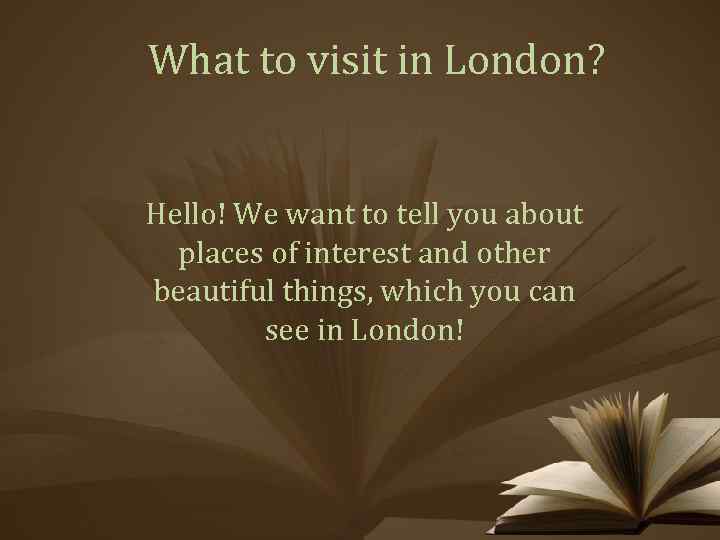 What to visit in London? Hello! We want to tell you about places of interest and other beautiful things, which you can see in London!
What to visit in London? Hello! We want to tell you about places of interest and other beautiful things, which you can see in London!
 Students • • • 1)Березина И. 2)Громов Р. 3)Данчишина В. 4)Дегтярева Ю. 5)Дыкова О. 6)Соловьева Ю. 7)Терехова М. 8)Тырышкина А. 9)Фроленко Д. 10)Ширяева А.
Students • • • 1)Березина И. 2)Громов Р. 3)Данчишина В. 4)Дегтярева Ю. 5)Дыкова О. 6)Соловьева Ю. 7)Терехова М. 8)Тырышкина А. 9)Фроленко Д. 10)Ширяева А.
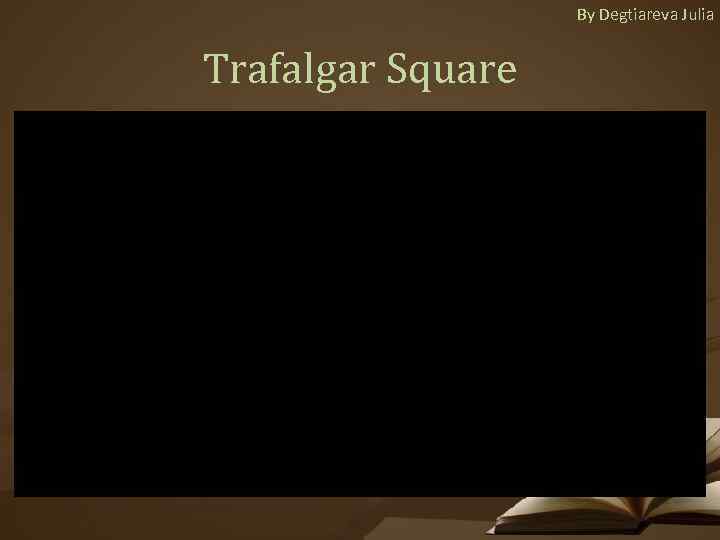 By Degtiareva Julia Trafalgar Square
By Degtiareva Julia Trafalgar Square
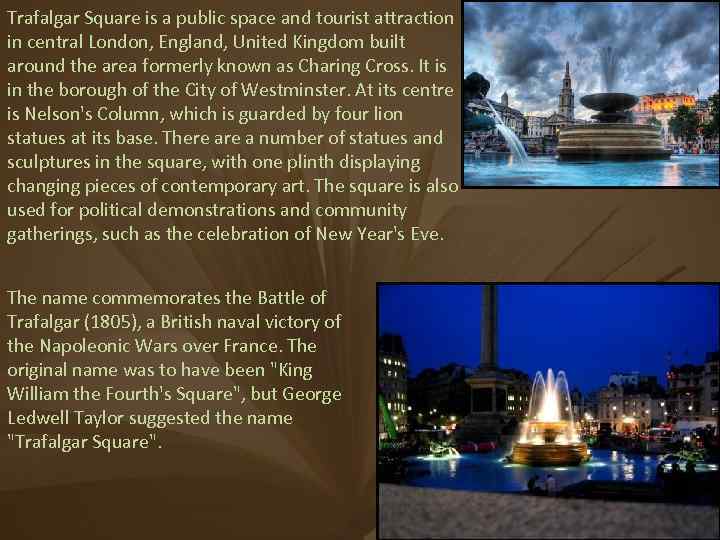 Trafalgar Square is a public space and tourist attraction in central London, England, United Kingdom built around the area formerly known as Charing Cross. It is in the borough of the City of Westminster. At its centre is Nelson's Column, which is guarded by four lion statues at its base. There a number of statues and sculptures in the square, with one plinth displaying changing pieces of contemporary art. The square is also used for political demonstrations and community gatherings, such as the celebration of New Year's Eve. The name commemorates the Battle of Trafalgar (1805), a British naval victory of the Napoleonic Wars over France. The original name was to have been "King William the Fourth's Square", but George Ledwell Taylor suggested the name "Trafalgar Square".
Trafalgar Square is a public space and tourist attraction in central London, England, United Kingdom built around the area formerly known as Charing Cross. It is in the borough of the City of Westminster. At its centre is Nelson's Column, which is guarded by four lion statues at its base. There a number of statues and sculptures in the square, with one plinth displaying changing pieces of contemporary art. The square is also used for political demonstrations and community gatherings, such as the celebration of New Year's Eve. The name commemorates the Battle of Trafalgar (1805), a British naval victory of the Napoleonic Wars over France. The original name was to have been "King William the Fourth's Square", but George Ledwell Taylor suggested the name "Trafalgar Square".
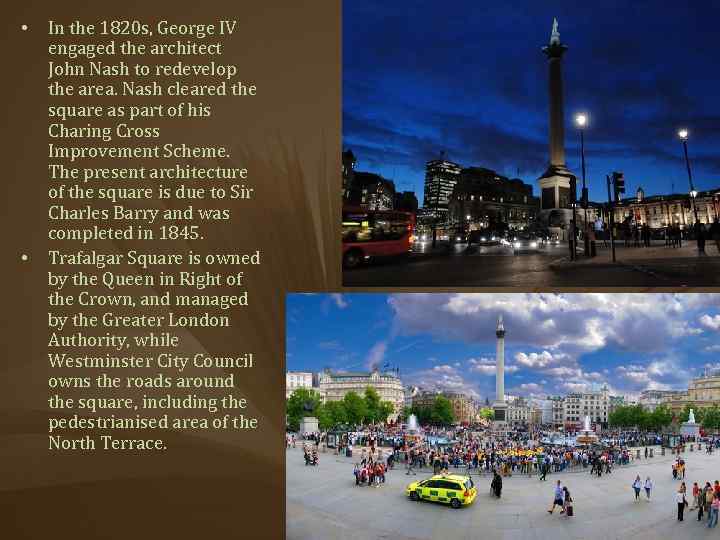 • • In the 1820 s, George IV engaged the architect John Nash to redevelop the area. Nash cleared the square as part of his Charing Cross Improvement Scheme. The present architecture of the square is due to Sir Charles Barry and was completed in 1845. Trafalgar Square is owned by the Queen in Right of the Crown, and managed by the Greater London Authority, while Westminster City Council owns the roads around the square, including the pedestrianised area of the North Terrace.
• • In the 1820 s, George IV engaged the architect John Nash to redevelop the area. Nash cleared the square as part of his Charing Cross Improvement Scheme. The present architecture of the square is due to Sir Charles Barry and was completed in 1845. Trafalgar Square is owned by the Queen in Right of the Crown, and managed by the Greater London Authority, while Westminster City Council owns the roads around the square, including the pedestrianised area of the North Terrace.
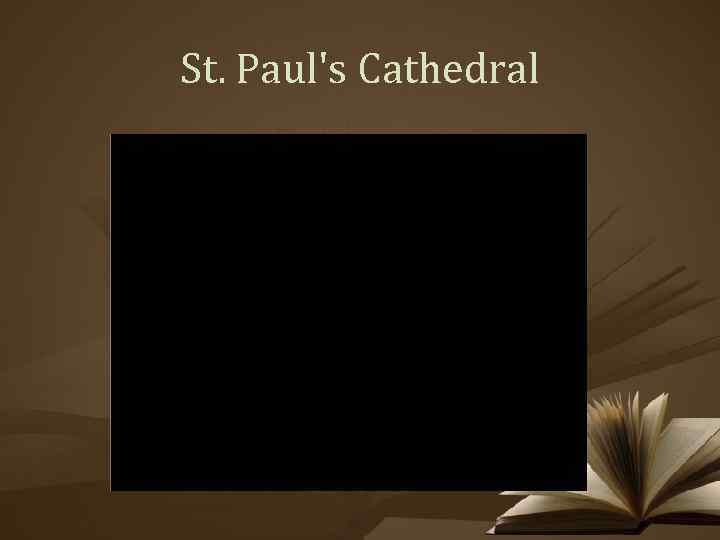 St. Paul's Cathedral
St. Paul's Cathedral
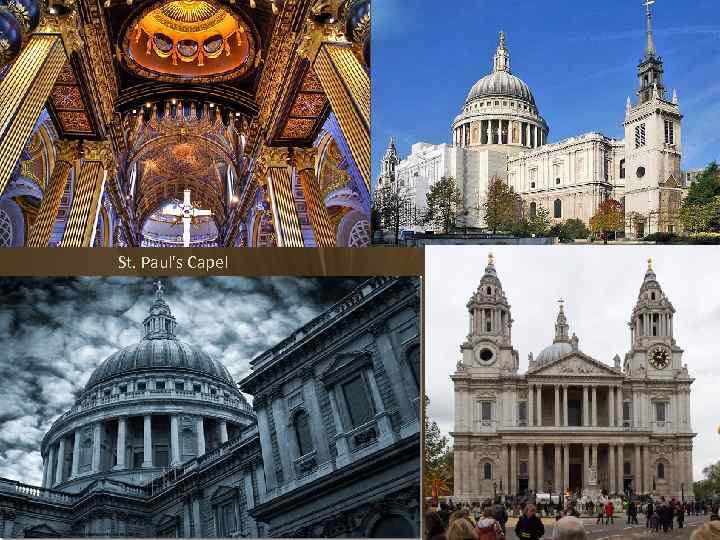 St. Paul's Capel
St. Paul's Capel
 Big Ben
Big Ben
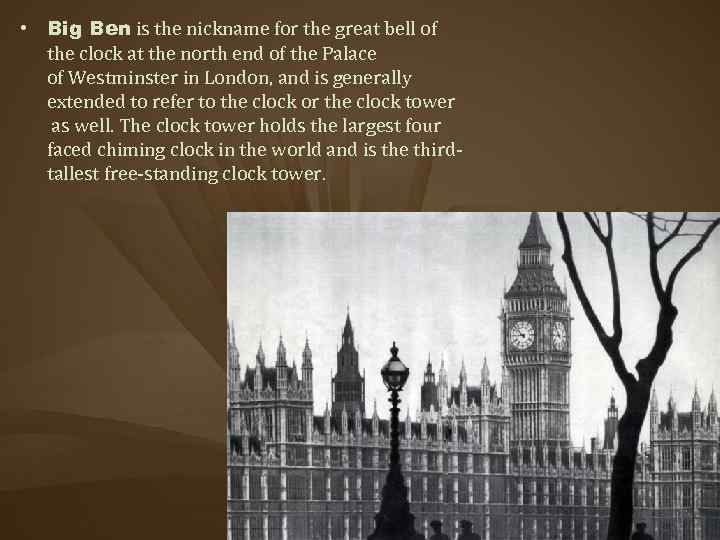 • Big Ben is the nickname for the great bell of the clock at the north end of the Palace of Westminster in London, and is generally extended to refer to the clock or the clock tower as well. The clock tower holds the largest four faced chiming clock in the world and is the thirdtallest free-standing clock tower.
• Big Ben is the nickname for the great bell of the clock at the north end of the Palace of Westminster in London, and is generally extended to refer to the clock or the clock tower as well. The clock tower holds the largest four faced chiming clock in the world and is the thirdtallest free-standing clock tower.
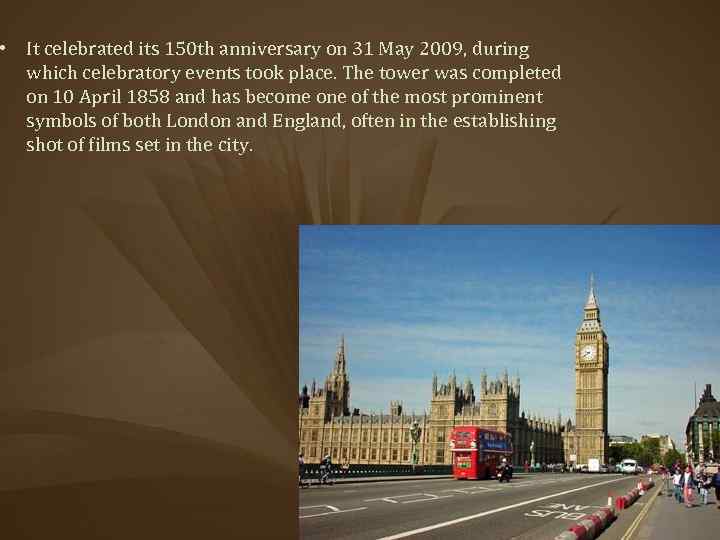 • It celebrated its 150 th anniversary on 31 May 2009, during which celebratory events took place. The tower was completed on 10 April 1858 and has become one of the most prominent symbols of both London and England, often in the establishing shot of films set in the city.
• It celebrated its 150 th anniversary on 31 May 2009, during which celebratory events took place. The tower was completed on 10 April 1858 and has become one of the most prominent symbols of both London and England, often in the establishing shot of films set in the city.
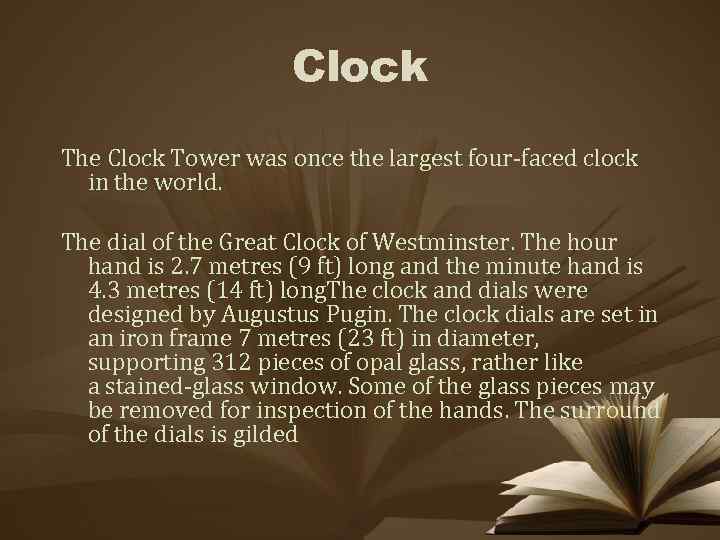 Clock The Clock Tower was once the largest four-faced clock in the world. The dial of the Great Clock of Westminster. The hour hand is 2. 7 metres (9 ft) long and the minute hand is 4. 3 metres (14 ft) long. The clock and dials were designed by Augustus Pugin. The clock dials are set in an iron frame 7 metres (23 ft) in diameter, supporting 312 pieces of opal glass, rather like a stained-glass window. Some of the glass pieces may be removed for inspection of the hands. The surround of the dials is gilded
Clock The Clock Tower was once the largest four-faced clock in the world. The dial of the Great Clock of Westminster. The hour hand is 2. 7 metres (9 ft) long and the minute hand is 4. 3 metres (14 ft) long. The clock and dials were designed by Augustus Pugin. The clock dials are set in an iron frame 7 metres (23 ft) in diameter, supporting 312 pieces of opal glass, rather like a stained-glass window. Some of the glass pieces may be removed for inspection of the hands. The surround of the dials is gilded
 At the base of each clock dial in gilt letters is the Latin inscription: “DOMINE SALVAM FAC REGINAM NOSTRAM VICTORIAM PRIMAM” Which means O Lord, keep safe our Queen Victoria the First.
At the base of each clock dial in gilt letters is the Latin inscription: “DOMINE SALVAM FAC REGINAM NOSTRAM VICTORIAM PRIMAM” Which means O Lord, keep safe our Queen Victoria the First.
 The Sherlock Holmes Museum
The Sherlock Holmes Museum

 Tower Bridge
Tower Bridge
 Tower Bridge (built 18861894) is a combined bascule and suspension bridge in London, England, over the River Thames. It is close to the Tower of London, from which it takes its name. It has become an iconic symbol of London.
Tower Bridge (built 18861894) is a combined bascule and suspension bridge in London, England, over the River Thames. It is close to the Tower of London, from which it takes its name. It has become an iconic symbol of London.
 British museum
British museum
 History 1. Sir Hans Sloane, founder of the British Museum. 2. Foundation (1753). 3. Growth and change (1800 -25). 4. New century, new building (1900 -25)
History 1. Sir Hans Sloane, founder of the British Museum. 2. Foundation (1753). 3. Growth and change (1800 -25). 4. New century, new building (1900 -25)
 Sir Hans Sloane, founder of the British Museum • Though principally a museum of cultural art objects and antiquities today, the British Museum was founded as a "universal museum". Its foundations lie in the will of the physician and naturalist Sir Hans Sloane (1660– 1753). During the course of his lifetime Sloane gathered an enviable collection of curiosities and, not wishing to see his collection broken up after death, he bequeathed it to King George II, for the nation, for the princely sum of £ 20, 000.
Sir Hans Sloane, founder of the British Museum • Though principally a museum of cultural art objects and antiquities today, the British Museum was founded as a "universal museum". Its foundations lie in the will of the physician and naturalist Sir Hans Sloane (1660– 1753). During the course of his lifetime Sloane gathered an enviable collection of curiosities and, not wishing to see his collection broken up after death, he bequeathed it to King George II, for the nation, for the princely sum of £ 20, 000.
 Foundation (1753) • On 7 June 1753, King George II gave his formal assent to the Act of Parliament which established the British Museum
Foundation (1753) • On 7 June 1753, King George II gave his formal assent to the Act of Parliament which established the British Museum
 Growth and change (1800 -25) • In the early 19 th century the foundations for the extensive collection of sculpture began to be laid and Greek, Roman and Egyptian artefacts dominated the antiquities displays. After the defeat of the French Campaign in the Battle of the Nile, in 1801, the British Museum acquired more Egyptian sculpture and in 1802 King George III presented the Rosetta Stone – key to the deciphering of hieroglyphs.
Growth and change (1800 -25) • In the early 19 th century the foundations for the extensive collection of sculpture began to be laid and Greek, Roman and Egyptian artefacts dominated the antiquities displays. After the defeat of the French Campaign in the Battle of the Nile, in 1801, the British Museum acquired more Egyptian sculpture and in 1802 King George III presented the Rosetta Stone – key to the deciphering of hieroglyphs.
 New century, new building (1900 -25) • By the last years of the nineteenth century, The British Museum's collections had increased so much that the Museum building was no longer big enough for them. All the while, the collections kept growing.
New century, new building (1900 -25) • By the last years of the nineteenth century, The British Museum's collections had increased so much that the Museum building was no longer big enough for them. All the while, the collections kept growing.
 Saatchi Gallary
Saatchi Gallary

 Buckingham Palace
Buckingham Palace
 Buckingham Palace. This is the principal façade, the East Front Bearskins The Royal Family on the balcony in 1986 The Ballroom is the largest room at Buckingham Palace.
Buckingham Palace. This is the principal façade, the East Front Bearskins The Royal Family on the balcony in 1986 The Ballroom is the largest room at Buckingham Palace.
 MADAME TUSSAUD`S MUSEUM
MADAME TUSSAUD`S MUSEUM
 Elizabeth II and the Duke of Edinburgh Marie Tussaud Prince Charles and his wife Camilla
Elizabeth II and the Duke of Edinburgh Marie Tussaud Prince Charles and his wife Camilla
 BARACK OBAMA DIANA VLADIMIR PUTIN
BARACK OBAMA DIANA VLADIMIR PUTIN
 BENNY HILL ARNOLD SCHWARZENEGGER CHARLIE CHAPLIN
BENNY HILL ARNOLD SCHWARZENEGGER CHARLIE CHAPLIN
 Corona of the Britannic empire
Corona of the Britannic empire
 • Corona of the Britannic empire — behaves to the so-called Valuables of Korony — royal regalias, jeweller decorations, to belongings not personally to the Britannic monarch, but to the state. • The Crown is of a design similar to St Edward's Crown: it includes a base of four crosses pattee alternating with four fleursde-lis, above which are four half-arches surmounted by a cross. Inside is a velvet cap with an ermine border. The Imperial State Crown includes many precious gems, including: 2, 868 diamonds, 273 pearls, 17 sapphires, 11 emeralds, and 5 rubies.
• Corona of the Britannic empire — behaves to the so-called Valuables of Korony — royal regalias, jeweller decorations, to belongings not personally to the Britannic monarch, but to the state. • The Crown is of a design similar to St Edward's Crown: it includes a base of four crosses pattee alternating with four fleursde-lis, above which are four half-arches surmounted by a cross. Inside is a velvet cap with an ermine border. The Imperial State Crown includes many precious gems, including: 2, 868 diamonds, 273 pearls, 17 sapphires, 11 emeralds, and 5 rubies.


